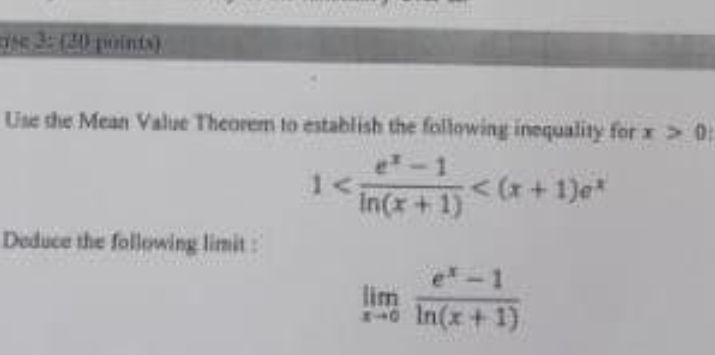AI tutor
Welcome to Bytelearn!
Let’s check out your problem:

Use the Mean Value Theorem to establish the following inequality for x>0 :1<\frac{e^{x}-1}{\ln (x+1)}<(x+1) e^{x}Deduce the following limit :
Full solution
Q. Use the Mean Value Theorem to establish the following inequality for :Deduce the following limit :
- Function Analysis: Let's consider the function on the interval where x > 0. According to the Mean Value Theorem, there exists some in such that .
- Derivative Calculation: First, we calculate which is the derivative of . The derivative is .
- Mean Value Theorem Application: Now, applying the Mean Value Theorem, we get for some in . Since is an increasing function, we have e^0 < e^c < e^x, which means 1 < e^c < e^x.
- Inequality Formation: Multiplying all sides of the inequality by , we get x < x\cdot e^c < x\cdot e^x. Since , we can substitute to get x < e^x - 1 < x\cdot e^x.
- Function Analysis: Now, let's consider the function on the interval . We apply the Mean Value Theorem again to find that there exists some in such that .
- Derivative Calculation: We calculate , which is the derivative of . The derivative is .
- Mean Value Theorem Application: Applying the Mean Value Theorem to , we get for some in . Since is a decreasing function, we have \frac{1}{x+1} < \frac{1}{d+1} < 1.
- Inequality Formation: Multiplying all sides of the inequality by , we get \frac{x}{x+1} < \ln(x+1) < x. Since , we can substitute to get \frac{x}{x+1} < \ln(x+1) < x.
- Combined Inequalities: Now, we combine the inequalities we have for and . We have x < e^x - 1 < x*e^x and rac{x}{x+1} < ext{ln}(x+1) < x. Dividing the first inequality by the second, we get rac{ rac{x}{x+1}}{x} < rac{e^x - 1}{ ext{ln}(x+1)} < rac{x*e^x}{x}/ rac{x+1}{x}.
- Limit Deduction: Simplifying the inequality, we get \frac{1}{x+1} < \frac{e^x - 1}{\ln(x+1)} < e^x. Since x > 0, we can multiply all sides by to get $\(1\) < \frac{e^x - \(1\)}{\ln(x+\(1\))} < (x+\(1\))e^x.
- L'Hôpital's Rule Application: To deduce the limit as \(x\) approaches \(0\), we observe that both the numerator \(e^x - 1\) and the denominator \(\ln(x+1)\) approach \(0\) as \(x\) approaches \(0\). By applying L'Hôpital's Rule, we can find the limit of the ratio as \(x\) approaches \(0\).
- Limit Calculation: Applying L'Hôpital's Rule, we differentiate the numerator and the denominator. The derivative of the numerator \(e^x - 1\) is \(e^x\), and the derivative of the denominator \( ext{ln}(x+1)\) is \(1/(x+1)\).
- Limit Calculation: Applying L'Hôpital's Rule, we differentiate the numerator and the denominator. The derivative of the numerator \(e^x - 1\) is \(e^x\), and the derivative of the denominator \( ext{ln}(x+1)\) is \(1/(x+1)\).Taking the limit as \(x\) approaches \(0\) of the derivatives, we get \( ext{lim}_{x o 0} rac{e^x}{1/(x+1)} = ext{lim}_{x o 0} e^x imes (x+1) = 1 imes (0+1) = 1\).
- Limit Calculation: Applying L'Hôpital's Rule, we differentiate the numerator and the denominator. The derivative of the numerator \(e^x - 1\) is \(e^x\), and the derivative of the denominator \( ext{ln}(x+1)\) is \(1/(x+1)\).Taking the limit as \(x\) approaches \(0\) of the derivatives, we get \( ext{lim}_{x \to 0} \frac{e^x}{1/(x+1)} = ext{lim}_{x \to 0} e^x * (x+1) = 1 * (0+1) = 1\).Therefore, the limit of \( rac{e^x - 1}{ ext{ln}(x+1)}\) as \(x\) approaches \(0\) is \(e^x\)\(0\).
